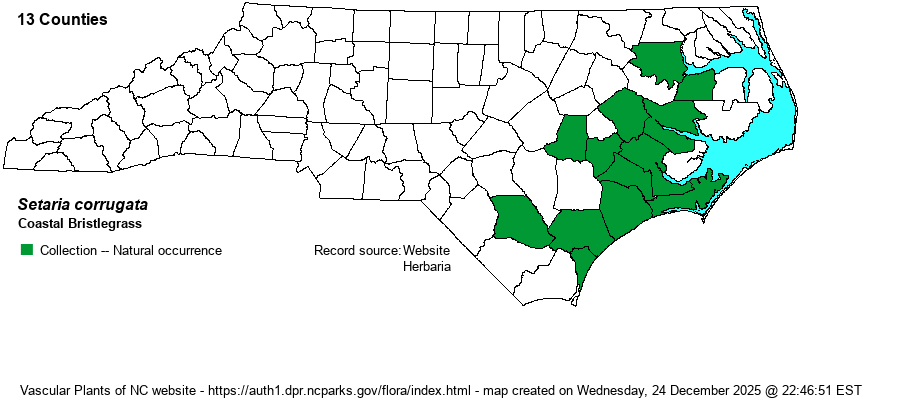| Author | (Elliott) J.A. Schultes | |
| Distribution | Outer and middle Coastal Plain. Absent from the Outer Banks and barrier islands, as well as in the northeastern counties (as it does not range into VA).
Coastal Plain, NC to southern FL and eastern TX; Cuba, Dom. Rep. | |
| Abundance | Uncommon. With a State Rank of S2S3, it is not quite scarce enough to be a Watch List species. | |
| Habitat | Dry to xeric pine woodlands, pine--Live Oak woodlands, pine--Turkey Oak sandhills, sandy fields, roadsides, scrapes. Considering its reasonably common habitats, it is indeed a surprise it is not more numerous than it is. | |
| Phenology | Flowering and fruiting June-August. | |
| Identification | Coastal Bristlegrass has upper lemmas that are coarsely ribbed crosswise, versus smooth in Giant Bristlegrass (S. magna). Each spikelet has 1-3 bristles from the base, versus 4-9 bristles in Marsh Bristlegrass (S. parviflora). This species has culms reaching only 1-2 feet tall, shorter than in some others in the genus. | |
| Taxonomic Comments | None
The inflorescences of bristlegrasses look like bottlebrushes, due to the numerous bristles that stick out sideways or that angle upward. Two of our 3 native species are annuals; S. parviflora is perennial. When using keys, make sure to have mature fruiting plants and a dissecting scope to see such features as the surface texture on lemmas, number of bristles per spikelet, etc. | |
| Other Common Name(s) | None | |
| State Rank | S2S3 | |
| Global Rank | G5? | |
| State Status | | |
| US Status | | |
| USACE-agcp | | |
| USACE-emp | | |

